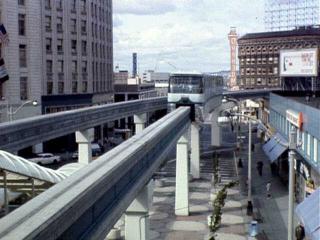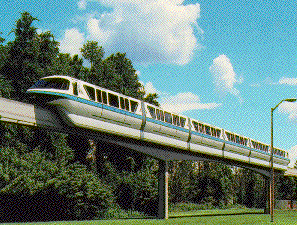Monorail General Information
GOTO - Monolink, for a collection of some current monorail technologies and concepts
Click here for current Monorail news
This infopage contains some information about straddle-type or beam-riding monorails. The ALWEG monorail in Seattle is an example that has been in continuous service since the World's Fair in 1962. Shown below is a photo of this monorail. It is approximately 1 mile long and connects Seattle Center (the site of the World's Fair) with a station in downtown Seattle. The ride takes about 90 seconds, end to end. Additional photos of the Seattle monorail guideway in various downtown locations are available. An excellent aerial photo of the monorail guideway is also available. Due to an accident, it is not currently (September, 2006) being operated.
On November 4, 1997, Seattle voters approved an initiative that called for extending the monorail system throughout the city. More information about the initiative including its full text and voter phamphlet text is available at the Public Interest Transit Forum website. Links to three articles about the monorail initiative from the Daily Journal of Commerce are also provided. One was written before the election, the other after the election. A third is dated 11/10/97. A fourth article examines the relationship between the RTA rail/bus plan and the monorail initiative (11/20/97).
An especially informative and provocative article about the monorail initiative published in the SeattleWeekly before the election is also provided. A second article was published 12/10/97. The Monorail Opportunity by Emory Bundy, written in early January, 1998, is well worth reading. A monorail conference was held in Seattle on March 4, 1998. A good review of the conference by Jon Savelle of the Daily Journal of Commerce is provided.
Rick Anderson of the Seattle Weekly has written several articles about the Seattle monorail. A recent article (2005) is "A $6 Billion Monorail? which notes that the cost of building the Green line and the cost of borrowing the money to do it wete both unknowns at this time. One can find his other articles by using the search routine at www.seattleweekly.com
For some history on this matter, links are provided to three articles from the Daily Journal of Commerce. One (May 20th) describes a new transit coalition called the Seattle Transit Initiative. A second (July 10th) notes that the monorail still faces an uphill battle . A third (July 16th) suggests that private financing for a Seattle monorail appears to be unlikely. More recent information can be found by doing a "monorail" search on the Headlines category at the Daily Journal of Commerce website (www.djc.com ). The center of action on monorail activity is the Elevated Transportation Company (ETC) of Seattle (www.elevated.org ).
See the Switch Myth page for information about various types of monorail switches and their application around the world.


Equally well known is the monorail at Disneyworld in Orlando, Florida (shown above). This technology uses an in-track switch that involves moving two beams into alternate postions (see photo below that shows this sequence of beam movement). This technology is available from Bombardier of Canada. For more detail on monorail switches, see the Switch Myth page.
![[switch photo]](bomb12.gif)
Bombardier also offers a UM III monorail that is designed for circulation and distribution applications. The UM III technology (see sketch below) is an electrically propelled, automatically controlled straddle-type monorail based on the highly successful Universal Mobility Inc. monorail which was installed in nine U.S. locations over a 20-year period. This technology was acquired by Bombardier in 1989 and is currently available from them.
The UM III can be configured as single vehicles or in multicar trains up to 10 vehicles in length. Each car is configured with seats for 8 people and provides standing room for up to 21. It travels on a steel guideway beam that is 29 inches wide. The guideway is typically elevated at 15 to 20 feet above the ground and standard span lengths are approximately 70 feet with longer spans available when necessary. The technology can also be deployed at grade, as is the case at the Tampa International Airport. People-moving capacity can range from between 1000 to 10,000 passengers per hour per direction in elevated, at-grade or underground applications. Maximum service speed is 32 kph and the maximum sustained gradient is about 6%. The installation at the Tampa Airport is 1 km in length and features 7 stations, with an average spacing of 400 feet. In began service in 1991. These vehicles operate at 19 km/h with peak headways of 90 seconds.
![UM III monorail sketch]](umiii1.jpg)
The most extensive application of monorail technology in the world today has been in Japan. The applications are well described in a video that is available from the Monorail Society . Additional detail can be found in the newsletter published by the Monorail Society. Two examples of these Japanese systems are shown below. The first picture is the Osaka monorail and the second is the monorail that serves the Tokyo-Haneda Airport.
![[Osaka monorail]](osaka.gif)
![[Tokyo-Haneda airport
monorail]](haneda.jpg)
In the U.S., the most recent monorail project has been in Las Vegas where a new 1-mile system was recently opened that connects Bally's with the MGM casino. It is possible that it will eventually be extended to the airport. Two recent photos of this installation are shown below.
![[las vegas monorail
photo]](lasveg2.gif)
![[photo of las vegas
monorail]](lasveg1.gif)
Another monorail project has recently been constructed at the Newark International Airport in New Jersey. More details and six photos have been provided for those interested in this project. The technology that has been used is very similar to the Von Roll monorail that has been built in downtown Sydney, Australia.
Garrett Briggs is a graphic artist with a special interest in monorails. Two thumbnail examples of his work are shown below - click them to see the full-size images (88 and 67 kbytes)

Further information on straddle-beam and other monorail technologies can be obtained from the Monorail Society website or by contacting the Monorail Society, directly.
Bombardier Inc ., UTDC Systems Division, P.O.Box 220, Stn.A, Kingston, Ontario, Canada K7M 6R2 (613) 384-3100
A description of Japanese monorails is available in the following article: Kikuchi, Shinya and Katsutoshi Ohta, 1989, "Development of Advanced Technology Transit Modes in Japan", Journal of Advanced Transportation, 23:2-3, 137-164.
Information about a gyro-stabilized monorail concept is also provided.
Last modified:July 11, 2017

